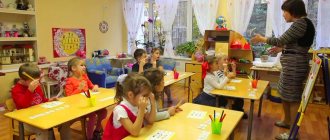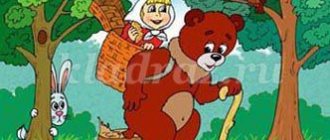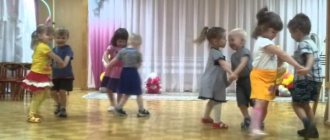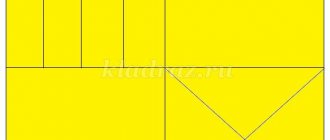Summary of a math lesson in the junior group “One, many, the same, more, less”
Summary of a lesson with children 3-4 years old on the topic “One, many, the same, more, less”
Author:
Alla Aleksandrovna Yakovleva
Description: this lesson summary will be useful for educators working with children 3-4 years old. Goal: to consolidate the concepts of “one”, “many”, “same”, “more”, “less”. Program content • Educational objectives:
– continue to teach how to determine the number of objects – one or many;
– continue to teach the comparison of equal and unequal sets through application; – exercise the ability to name primary colors: green, blue; – practice the ability to arrange objects with your right hand from left to right. • Developmental tasks:
– develop the ability to analyze, compare, generalize.
• Educational task:
– to develop the skills of polite greeting and farewell, to cultivate hospitality.
Vocabulary work: “many flashlights”, “one flashlight”; “multi-colored lanterns”, “blue lantern”, “green lantern”; “there are as many lanterns as teddy bears”; “one at a time”, “not a single one”; “there are more bear cubs than lanterns,” “there are fewer lanterns than bear cubs.” Aids Demonstration material (D):
paper bear, colorful box.
Handout (P):
a card with a picture of three teddy bears, one blue or green lantern, a tray with four small lantern figures.
Progress of the lesson
Children sit in a semicircle.
There's a knock on the door. A bear comes to visit. Educator: Guys, look who came to us?
Children: Bear. Educator: Let's say hello to Mishka. Children: Hello, Mishka! Bear: Hello, guys! I am very glad to see you! Educator: And we are glad to see you, Mishka. Yes, you didn’t come to us empty-handed! Guys, Mishka brought a box. Bear, is this for us? Bear: Yes. These are my gifts to you. Educator: How attentive you are, Mishka! Can I see what's in your beautiful box? Guys, let's see what Mishka brought us? (Opens the box and takes out the flashlights.)
Guys, tell me, what is this?
Children: Flashlights. Mishka brought us lanterns. Educator: How many lanterns did Mishka bring us? Children: A lot. Educator: That's right, Mishka brought us a lot of lanterns. Nastya, tell me, how many lanterns did Mishka bring? Nastya: Lots of flashlights. Educator: How many bears came to us? Children: One. Educator: One bear brought us a lot of lanterns. And they are all different colors. You could say: multi-colored lanterns. Let's all say it together: colorful lanterns. Children: Multi-colored lanterns. Educator: Bear, thank you for such beautiful colorful lanterns! Children, take one flashlight each. (All children take one flashlight from the box. The teacher asks each child how many flashlights he takes.)
Let each of you look carefully at your flashlight and think what color it is.
And Mishka will ask who has what color flashlight. Bear: Nastya, how many flashlights do you have? Nastya: Alone. Bear: Seryozha, what color is your flashlight? Seryozha: Green. Bear: Who else has green flashlights? Raise the green lanterns. (Children raise green lanterns.)
How beautifully they burn!
Lower the green lights. Sasha, what color is your flashlight? Sasha: I have a blue flashlight. Bear: Who else has a blue flashlight? Raise the blue lanterns. (Children raise blue lanterns.) Educator: It turns out that Mishka brought us green and blue lanterns. And now he wants to play the game “Colorful Lanterns” with you. When I say: “The blue lanterns are lit,” those guys who have a blue lantern need to get up and walk around the room with it, “illuminate” it. And when I say: “The green lanterns are lit,” those guys who have a green lantern need to do the same. So, evening came, the room became dark - it was time to turn on the lanterns. The blue lanterns came on. (Children with blue lanterns walk around the room, “illuminating” it.)
Well done, how attentive you are: only blue lanterns “light up”!
The green lanterns came on. (The children stand up with green lanterns, and everyone walks around the room.)
The room has become very light, because both blue and green lanterns are burning.
But then morning came. First the blue lights went out. Have everyone with a blue flashlight squat down. (Children with blue lanterns squat down.)
Then the green lanterns went out.
(Children with green lanterns squat down.)
Guys, how many lanterns have gone out?
Children: A lot. Educator: Did you like the game? Thank you, Mishka, for the interesting entertainment! Children, how many flashlights do each of you have? Children: One at a time. Educator: How many flashlights are in the box? Children: None. Educator: Now put your flashlights in the box. (Children put lanterns in a box. The teacher asks each child how many lanterns he put in, what color.)
How many lanterns are there in the box?
Children: A lot. Educator: Everyone put one flashlight, and there were a lot in the box. Nastya, how many flashlights are there in the box? Nastya: A lot. Educator: Oh! Mishka tells me that he is in trouble. He lost his cubs because the forest is dark and the little bear cubs cannot find their way home. Guys, let's help the bear cubs? Shall we give lanterns to illuminate the road? Children: Yes, we will help. Educator: I prepared small lanterns, because the cubs are still babies. Let's go into the forest for Mishka. He will show us the way so that we do not get lost. (Children follow the teacher to the tables, following his instructions, performing various movements: “raising our legs high, stepping over bumps,” “jumping over a stream,” etc.)
Here we are in the forest. Look around carefully and find the lost cubs. Who did you find?
Children: We found cubs! Educator: How many cubs did you find? Children: A lot. Educator: Now I will give you flashlights. (Each child is given a tray with four lantern figures.)
Let's give each bear one lantern so that they all return home safely.
Guys, you need to take the flashlights with your right hand and lay them out from left to right. Raise all your right hands. (Children raise their right hand.)
In total, you need to take as many lanterns as the cubs.
Be careful: there may be extra flashlights left. (Children place lanterns next to the images of bear cubs.)
Guys, how many lanterns did you take?
Children: We took so many lanterns, so many bear cubs. Educator: Vitya, how many flashlights did you take? Vitya: I took as many flashlights as the cubs. Educator: What can you say about the number of lanterns and teddy bears? Children: There are as many bear cubs as there are lanterns; there are equal numbers of them. Educator: It turns out that another bear cub was found. (Places another bear cub on each child’s card.)
Guys, look who or what has become more numerous: bear cubs or lanterns?
Children: There are more bear cubs than lanterns. Educator: Who or what has become smaller: bear cubs or lanterns? Children: There are fewer lanterns than teddy bears. Educator: What do you think needs to be done so that there are equal numbers of teddy bears and lanterns? Children: Give this little bear one flashlight. Educator: Make sure that there are equal numbers of lanterns and bear cubs. (Children complete the task)
.
Lena, what did you do? Lena: I gave one flashlight to the bear cub. Educator: What can you now say about the number of teddy bears and lanterns? Children: There are as many bear cubs as there are lanterns. There are as many lanterns as there are cubs. There are the same number of teddy bears and lanterns. Educator: Bear says thank you. With flashlights, the cubs will easily find their home, and we will return to kindergarten. Let's say to Mishka and the cubs: “Goodbye!
Come to our kindergarten, we will always be glad to see you .
(Children repeat this phrase. Then everyone “returns” the same way, performing the same movements.)
Here we are in kindergarten.
Children, did you like it in the forest? What did you like most? Children: Help the cubs, give them lanterns. Educator: Did you like how Mishka and I played the game “Colorful Lanterns”? We gave the little bear cubs small lanterns, and Mishka gave us large lanterns. We are already big! We know how to play together. We know colors and know how to “light” either green or blue lanterns. We can compare the number of cubs and lanterns. Thanks to your skills, today none of the cubs were left without a flashlight. And we will take the lanterns that Mishka gave us for a walk and play different games with them.
We recommend watching:
Summary of GCD in mathematics in the younger group. The use of non-traditional forms of work in mathematics GCD for children of the junior group in mathematics “Bigger, smaller, smallest” Summary of a lesson in mathematics 2nd junior group “Geometric figures” Summary of a lesson on FEMP in the 2nd junior group. Journey to Geometry
Similar articles:
Summary of a mathematical game in the second junior group
Summary of the game in mathematics in the younger group
Mathematics lesson in the younger group “Parts of the day”
Summary of the lesson in mathematics “Number and figure 2”. Junior group
Summary of a mathematics lesson in the junior group “Coding geometric shapes”
Lesson notes on the topic: One. A lot of. (age 3-4 years)
Lesson notes on the topic: One. A lot of. (age 3-4 years)
Target:
Learn to find many similar objects in the environment and isolate one object from it.
Objectives:
To introduce the concepts of “one”, “many”. Work on the ability to coordinate the numeral “one” with nouns in gender and case. Get acquainted with the concept of “right” and “left” hand. Form spatial concepts (the concepts of “in front of, behind, above”).
Materials:
a basket with balls of different colors according to the number of children + 1 ball for the teacher.
During the classes.
1. Children sit on the carpet and play with their fingers to the rhyme “Let's count our fingers.” 1, 2, 3, 4, 5 we will count fingers. (we bend our fingers) Here is a fist, and here is a palm. (Show fist and palm) A cat sat on the palm and sneaks away slowly, (Another palm moves along the palm, fingering it) Maybe a mouse lives there? The cat is guarding the mouse. Meow! (Like a cat scratching her palm with her fingers, and quickly hide her hands from the cat at the last word)
2. The teacher has a basket with balls of different colors according to the number of children +1 to the teacher. - What is in my basket? (Balls) - How many balls do I have in the basket? (A lot) - I’ll take one ball. I have one red ball. - Sasha, take the ball. How many balls did you take? What kind of ball do you have? You have one green ball. Repeat. (Distribute all the balls) - How many balls were in the basket? A lot of. - Now how much is left? No one.
There were a lot of balls, we took one at a time, and not a single ball was left. 3. Physical exercise.
Take the ball in your right hand. (The teacher stands facing the children and shows all movements in a mirror image) Transfer the ball to your left hand. Raise the ball above your head. Hide it behind your back. Hold the ball in front of you. Jumping in place with a ball in your hands to the poem:
Girls and boys jumped up and down like balls. They jumped, got tired, stood up on their toes, slowly spun around and sank onto the mat.
4. Let's collect the balls in a basket.
— How many balls are there in the basket? (None) - I will put 1 red ball in the basket. - Sasha, put the ball in the basket. How many balls did you put in? (Collect all the balls in a basket) - How many balls are in the basket? (Many) -We put one at a time, and there were a lot of them.
5.Game "Train".
We were sitting, we were tired, and now we stood up together. They stamped their feet and clapped their hands. We will assemble a locomotive to take us on a visit.
Children move in a group one after another to the song “The locomotive is moving, the locomotive is moving,” with their hands on the shoulders of the person in front. The locomotive “drives up” to a corner of nature.
- What items do we have a lot of? Which item is one? (Many cones, one squirrel) Take the one object and place it on the table.
“Drive up” to the construction corner. — What kinds of objects are there a lot? Which one? (Many blue cubes, one red.) Take 1 cube from those that are many and place it on the table.
“Drive up” to the doll corner. There are toys at the table. - How many bears? (One) How many dogs? (One) How many dolls? (One) How many cats? (One) How many toys are there in total? (A lot) Take 1 toy and put it on the table. etc.
“Drive up” to the table. - What's on the table? What are they needed for? - These are toys, they are needed for that. to play. How many toys are on the table? (A lot of)
—What else can you say “many” or “one” about? 6. Lesson summary.
Which game did you like best? You and I counted which items were many and which were one at a time.





